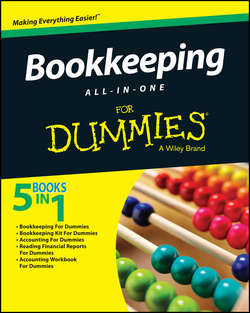Читать книгу Bookkeeping All-In-One For Dummies - Dummies Consumer - Страница 12
На сайте Литреса книга снята с продажи.
Book I
Keeping the Books
Chapter 1
Basic Bookkeeping
Pedaling through the Accounting Cycle
ОглавлениеAs a bookkeeper, you complete your work by completing the tasks of the accounting cycle. It’s called a cycle because the workflow is circular: entering transactions, controlling the transactions through the accounting cycle, closing the books at the end of the accounting period, and then starting the entire cycle again for the next accounting period.
The accounting cycle has eight basic steps, which you can see in Figure 1-1.
©John Wiley & Sons, Inc.
Figure 1-1: The accounting cycle.
1. Transactions: Financial transactions start the process. Transactions can include the sale or return of a product, the purchase of supplies for business activities, or any other financial activity that involves the exchange of the company’s assets, the establishment or payoff of a debt, or the deposit from or payout of money to the company’s owners. All sales and expenses are transactions that must be recorded. The basics of documenting business activities involve recording sales, purchases, and assets, taking on new debt, or paying off debt.
2. Journal entries: The transaction is listed in the appropriate journal, maintaining the journal’s chronological order of transactions. (The journal is also known as the “book of original entry” and is the first place a transaction is listed.)
3. Posting: The transactions are posted to the account that it impacts. These accounts are part of the General Ledger, where you can find a summary of all the business’s accounts.
4. Trial balance: At the end of the accounting period (which may be a month, quarter, or year depending on your business’s practices), you calculate a trial balance.
5. Worksheet: Unfortunately, many times your first calculation of the trial balance shows that the books aren’t in balance. If that’s the case, you look for errors and make corrections called adjustments, which are tracked on a worksheet. Adjustments are also made to account for the depreciation of assets and to adjust for one-time payments (such as insurance) that should be allocated on a monthly basis to more accurately match monthly expenses with monthly revenues. After you make and record adjustments, you take another trial balance to be sure the accounts are in balance.
6. Adjusting journal entries: Post any necessary corrections after the adjustments are made to the accounts. You don’t need to make adjusting entries until the trial balance process is completed and all needed corrections and adjustments have been identified.
7. Financial statements: You prepare the balance sheet and income statement using the corrected account balances.
8. Closing: You close the books for the revenue and expense accounts and begin the entire cycle again with zero balances in those accounts.
As a businessperson, you want to be able to gauge your profit or loss on month by month, quarter by quarter, and year by year bases. To do that, Revenue and Expense accounts must start with a zero balance at the beginning of each accounting period. In contrast, you carry over Asset, Liability, and Equity account balances from cycle to cycle because the business doesn’t start each cycle by getting rid of old assets and buying new assets, paying off and then taking on new debt, or paying out all claims to owners and then collecting the money again.
